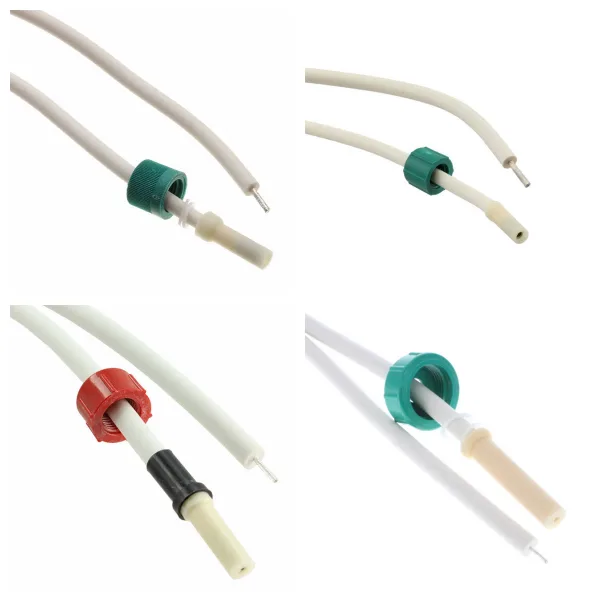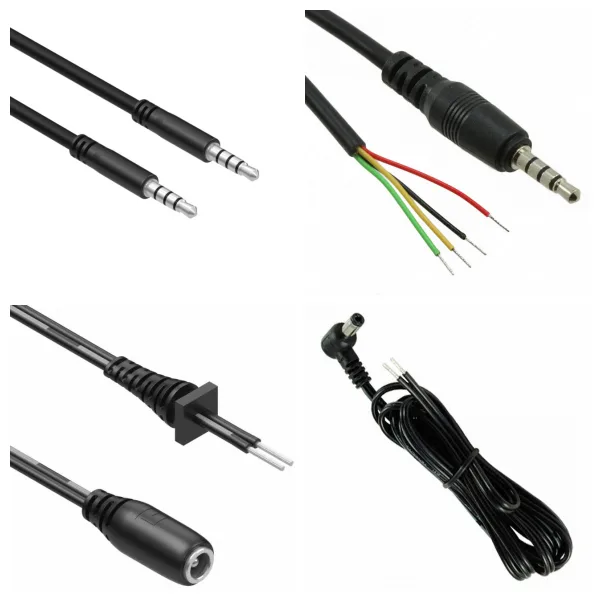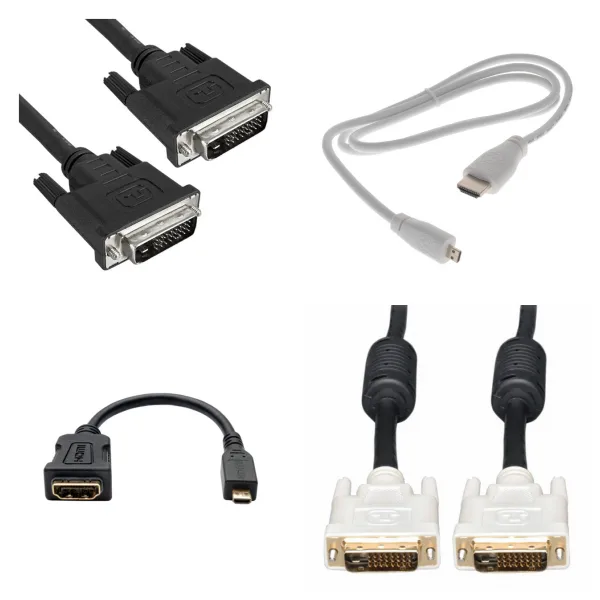
<h1> Video Cables (DVI, HDMI) </h1> <h2> 1. Video Cables Overview </h2> <p> Video cable is a special cable used to transmit video signals, usually composed of a conductor, insulation layer, shielding layer, and outer sheath. Depending on the purpose, it may contain a single-core coaxial structure (such as the SYV series) or a multi-core composite design (such as a composite cable with integrated power supply and signal transmission). Its core function is to ensure that the video signal remains clear and stable during transmission and reduce electromagnetic interference. </p> <p> </p> <h2> 2. What are the Types of Video Cables? </h2> <h3> 1) Classification by Interface Type </h3> <p> <strong>VGA</strong>: used for analog video transmission and connecting old display devices. </p> <p> <strong>HDMI</strong>: supports high-definition digital signals and audio synchronous transmission, divided into standard HDMI (Type A) and Mini-HDMI (Type C). </p> <p> <strong>DVI</strong>: divided into DVI-D (pure digital) and DVI-I (digital + analog), supporting single/dual link transmission. </p> <p> </p> <p> <strong>DisplayPort</strong>: similar to HDMI, but more commonly used for computer monitors. </p> <p> <strong>BNC/RCA</strong>: BNC is mostly used in professional monitoring equipment, and RCA (lotus head) is common in consumer-grade devices. </p> <p> </p> <h3> 2) Classification by Cable Structure </h3> <p> <strong>Coaxial Cable</strong>: Such as SYV50-3, it adopts a multi-layer structure of copper core + insulation layer + aluminum foil shielding + braided mesh, with an impedance of 75Ω, suitable for long-distance high-definition signal transmission. </p> <p> <strong>Composite Cable</strong>: Integrates video cable and power cable to simplify wiring complexity. </p> <p> </p> <h3> 3. What are the Structure and Materials of Video Cables? </h3> <p> <strong>1) Coaxial Cable</strong>: </p> <p> <strong>Inner Conductor</strong>: Copper core (single core or multi-strand twisted), the diameter affects the transmission performance (such as 75-3, 75-5, and other specifications). </p> <p> <strong>Shielding Layer</strong>: Aluminum foil + copper mesh braiding, double shielding enhances anti-interference ability. </p> <p> </p> <p> <strong>Sheath</strong>: PVC or PU material, providing wear-resistant and anti-bending protection. </p> <p> <strong>2) Composite Cable</strong>: The power cable is integrated in parallel on the basis of the video cable, and the integrated design is realized through the common mold extrusion process. </p> <p> </p> <h2> 4. What are the Technical Parameters of Video Cables? </h2> <p> <strong>1) Transmission Distance</strong>: </p> <p> <strong>VGA</strong>: conventional 45 meters, up to 200 meters after expansion. </p> <p> <strong>DVI</strong>: 15 meters for digital signal and only 5 meters for analog signal. </p> <p> <strong>Coaxial Cable (such as SYV75-5)</strong>: up to 300 meters. </p> <p> </p> <p> <strong>2) Signal Quality</strong>: A high-stranded shielding layer can reduce signal attenuation, and bandwidth performance determines the supported resolution (such as SYV50-3 supports ultra-high definition). </p> <p> </p> <h2> 5. Where are Video Cables Used? </h2> <p> <strong>Security Monitoring</strong>: A coaxial cable is used to connect the camera to the control center to ensure the stability of real-time images. </p> <p> <strong>Broadcasting and Television</strong>: HDMI and DisplayPort are used for the interconnection of high-definition audio and video equipment. </p> <p> </p> <p> <strong>Industry and Intelligent Systems</strong>: composite cables support multi-signal synchronous transmission in the fields of intelligent transportation, medical treatment, etc. </p> <p> </p> <h2> 6. Manufacturing Process and Quality Requirements of Video Cables </h2> <p> <strong>Connector Process</strong>: BNC/RCA adopts crimping or welding, and aviation head connectors are widely used due to their high reliability and plug-in life. </p> <p> <strong>Testing Standards</strong>: electrical performance tests (such as impedance matching, and signal attenuation) and mechanical strength tests (such as bending more than 100,000 times) are required. </p> <p>
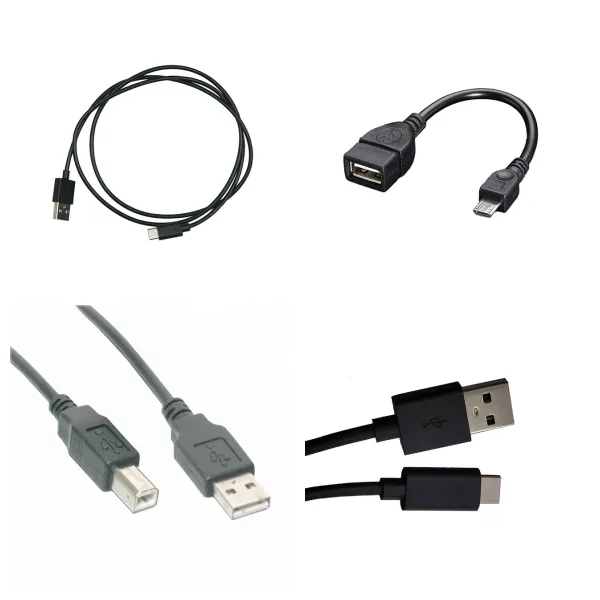
<h1> USB Cables </h1> <p> USB Cables (Universal Serial Bus Cables) are core components used to connect electronic devices and realize data transmission and power supply. </p> <p> </p> <h2> 1. USB Cables Overview </h2> <p> <strong>USB Cables follow the USB standard, use serial communication technology, transmit data bit by bit through a single wire, and integrate power supply functions. Its core functions include:</strong> </p> <p> <strong>Bidirectional Communication</strong>: support data interaction between device and host; </p> <p> <strong>Power Transmission</strong>: provide 5V basic voltage, which can be expanded to 20V, and the power supply power reaches 100W; </p> <p> <strong>Plug and Play</strong>: support hot plugging, and the connection can be recognized without restarting the device. </p> <p> </p> <h2> 2. What are the Physical Structure of USB Cables? </h2> <p> <strong>The standard USB 2.0 cable contains four independent cores (USB 3.0 and above versions add additional data channels)</strong>: </p> <p> </p> <p> <strong>VCC (Red)</strong>: provides a 5V power supply, the current limit varies depending on the version (such as 500mA for USB 2.0); </p> <p> </p> <p> <strong>GND (Black)</strong>: forms a power loop to ensure current stability; </p> <p> <strong>D+ (Green) and D- (White)</strong>: responsible for differential signal transmission to ensure data accuracy. </p> <p> </p> <h2> 3. What are the Interface Types of USB Cables? </h2> <p> <strong>The interface form of USB Cables has undergone many iterations</strong>: </p> <p> <strong>Type-A</strong>: rectangular design, commonly seen on the host side (such as computer USB port); </p> <p> <strong>Type-B</strong>: square or trapezoidal, mostly used for peripherals such as printers and mobile hard drives; </p> <p> <strong>Type-C</strong>: oval symmetrical design, supports positive and negative blind insertion, integrates high-speed transmission (USB4 up to 40Gbps) and high-power power supply capability, and has now become a mainstream interface. </p> <p> </p> <h2> 4. What are USB Cables Used for? </h2> <p> <strong>Device Interconnection</strong>: connecting computers and peripherals (such as keyboards, and mobile hard drives); </p> <p> <strong>Cross-device Transmission</strong>: data transmission between two devices is realized through a bridge cable (USB-to-USB); </p> <p> <strong>Fast Charging</strong>: The Type-C interface cooperates with the PD protocol to power high-power devices such as laptops and mobile phones. </p> <p> </p> <h2> 5. Technology Evolution Trend of USB Cables </h2> <p> From USB 1.0 (1.5Mbps) in 1996 to USB4 (40Gbps) in 2019, the transmission rate has increased by more than 2,600 times, and compatibility has continued to increase, supporting video output and multiprotocol expansion (such as Thunderbolt 3). The popularity of the Type-C interface marks the development of USB technology towards multi-functional integration. </p> <p>
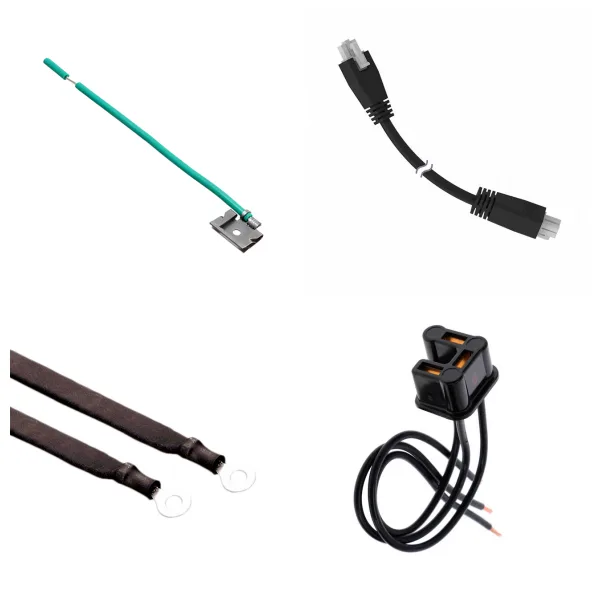
<h1> Specialized Cable Assemblies </h1> <p> Specialized Cable Assemblies are cable solutions customized to meet specific application scenarios or harsh environmental requirements. They ensure high reliability, high performance, and long life under complex conditions by combining special materials, structural design, and manufacturing processes. </p> <p> </p> <h2> 1. What are the Core Features of Specialized Cable Assemblies? </h2> <p> <strong>Customized Design</strong>: Customize parameters such as length, interface, shielding method, protection level, etc. according to customer needs to solve unique problems that standardized cables cannot meet. </p> <p> <strong>High-performance Materials</strong>: Use high-temperature resistant, corrosion-resistant, flame-retardant, or flexible materials (such as silicone, Teflon, and military-grade sheaths) to adapt to extreme temperatures, humidity, chemical corrosion, or mechanical stress. </p> <p> <strong>Signal Integrity</strong>: Reduce electromagnetic interference (EMI/RFI) through precision shielding (such as twisted pair, metal braided layer) and impedance control to ensure stable transmission of high-speed data or weak current signals (such as medical sensors). </p> <p> <strong>Harsh Environment Adaptation</strong>: With waterproof (IP67/IP68), oil-proof, UV-resistant, vibration-resistant, and other characteristics, it is suitable for outdoor, industrial, or military scenarios. </p> <p> </p> <h2> 2. Where are Specialized Cable Assemblies Used? </h2> <p> <strong>Medical Equipment</strong>: Cables for high-precision surgical instruments, MRI equipment, and patient monitors must comply with biocompatibility standards (such as ISO 13485) and resist corrosion from disinfectants. </p> <p> <strong>Industrial Automation</strong>: Robot joint cables (bending resistance), anti-interference buses for factory automation systems (such as PROFIBUS, EtherCAT). </p> <p> <strong>Aerospace and Defense</strong>: Lightweight, extreme temperature-resistant airborne cables that meet military standards such as MIL-STD-810G. </p> <p> <strong>Automobile and New Energy</strong>: High-voltage wiring harnesses for electric vehicles (600V+), high-speed data transmission for in-vehicle entertainment systems (such as FAKRA connectors). </p> <p> <strong>Communications and Data Centers</strong>: High-speed fiber optic components (such as QSFP-DD), and low-loss RF cables for 5G base stations. </p> <p> </p> <h2> 3. What is the Manufacturing Process of Specialized Cable Assemblies? </h2> <p> <strong>1) Requirements Analysis</strong>: Clarify goals such as electrical performance, mechanical strength, and environmental tolerance. </p> <p> <strong>2) Prototype Design</strong>: Use simulation software to optimize wiring, heat dissipation, and stress distribution. </p> <p> <strong>3) Material Selection</strong>: For example, polyimide insulation is used in the aerospace field, and TPE (thermoplastic elastomer) sheath is used in the automotive industry. </p> <p> <strong>4) Precision Assembly</strong>: Connector stability is ensured through automated crimping, welding, or injection molding processes. </p> <p> <strong>5) Strict Testing</strong>: </p> <p> <strong>Electrical testing</strong>: conductivity, withstand voltage (HIPOT test), signal attenuation. </p> <p> </p> <p> <strong>Mechanical testing</strong>: bending life (such as 100,000 cycles), tensile strength. </p> <p> </p> <p> <strong>Environmental testing</strong>: high and low-temperature cycles (-55 °C to 125 °C), salt spray test. </p> <p> </p> <p> <strong>4. What are the Industry Standards of Specialized Cable Assemblies?</strong> </p> <p> <strong>International Standards</strong>: UL (safety certification), ISO 9001/14001 (quality and environmental management), RoHS/REACH (environmental compliance). </p> <p> <strong>Field-specific Standards</strong>: ISO 16750 for the automotive industry, IEC 60601-1 for medical, AS/EN 9100 for aviation. </p> <p> </p> <h2> 5. What are the Market Trends of Specialized Cable Assemblies? </h2> <p> <strong>High-Speed and Miniaturization</strong>: Support higher frequencies (such as 112Gbps PCIe 6.0) and compact connectors (such as micro coaxial). </p> <p> <strong>Intelligent Integration</strong>: Embed sensors to monitor real-time status such as temperature and strain to achieve predictive maintenance. </p> <p> <strong>Sustainability</strong>: Use recyclable materials (such as bio-based plastics) and low-energy manufacturing processes. </p> <p> <strong>Emerging Field Drivers</strong>: Autonomous driving LiDAR systems, renewable energy (such as photovoltaic cables), and ultra-light cables for space exploration. </p> <p> </p> <h2> 6. How to Choose Specialized Cable Assemblies? </h2> <p> <strong>Technical Experience</strong>: Whether there are successful cases of similar projects (such as submarine cables and nuclear facility applications). </p> <p> <strong>Customization Capabilities</strong>: Quick response to design changes and support small-batch trial production. </p> <p> <strong>Full-cycle Service</strong>: A one-stop solution from design support to after-sales maintenance. </p> <p> <strong>Summary</strong> </p> <p> Specialized cable assemblies are the "blood vessels and nerves" of high-end manufacturing. Their technical barriers lie in the deep integration of material science, precision engineering, and scenario-based needs. With the advancement of intelligent and green trends, customized and highly reliable cable solutions will become the key support for the upgrading of various industries. </p> <p>
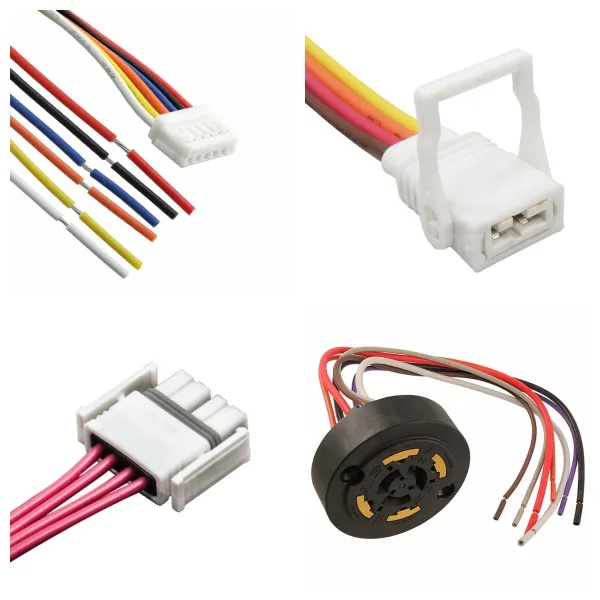
<h1> Solid State Lighting Cables </h1> <h2> 1. What are Solid State Lighting Cables? </h2> <p> SSL Cables are connection cables designed for SSL devices. They are mainly used to support power transmission, signal control, and data communication of solid-state light sources such as LED (light-emitting diode) and OLED (organic light-emitting diode). Such cables are widely used in indoor/outdoor lighting systems, automotive lighting, display screens, smart homes, and industrial automation. </p> <p> </p> <h2> 2. What are the Core Features of Solid State Lighting Cables? </h2> <p> <strong>Efficient Power Transmission</strong> </p> <p> Supports low voltage (such as 12V/24V DC) and high current requirements, and adapts to the input requirements of LED driver power supply. </p> <p> </p> <p> Low resistance design reduces energy loss and improves the overall energy efficiency of the lighting system. </p> <p> </p> <p> <strong>Signal and Data Integration</strong> </p> <p> Some cables integrate PWM (pulse width modulation) signal lines or DMX control lines to adjust brightness, color temperature, or dynamic lighting effects. </p> <p> </p> <p> I²C, DALI, and other communication protocols may be integrated into smart lighting systems to achieve network control. </p> <p> </p> <p> <strong>High-Temperature Resistance and Durability</strong> </p> <p> Use high-temperature resistant insulation materials (such as silicone, TPU) to adapt to the heat generated by the long-term operation of LED lamps. </p> <p> </p> <p> Anti-bending and wear-resistant design ensures reliability in complex environments (such as car engine compartments and outdoor lighting). </p> <p> </p> <p> <strong>Environmental Protection and Safety Certification</strong> </p> <p> Complies with international standards such as RoHS, UL, and CE to ensure the absence of harmful substances and electrical safety. </p> <p> Flame retardant grades (such as VW-1) meet fire protection requirements. </p> <p> </p> <h2> 3. Where are Solid State Lighting Cables Used? </h2> <p> <strong>Architectural Lighting</strong>: Connect LED light strips, downlights, landscape lights, etc., and support dimming and color adjustment functions. </p> <p> </p> <p> <strong>Automotive Lighting</strong>: Used for power supply and control of interior atmosphere lights, taillights, and daytime running lights. </p> <p> </p> <p> <strong>Displays and Billboards</strong>: Provide stable power supply and data transmission for LED display modules. </p> <p> </p> <p> <strong>Smart Home</strong>: Integrated into smart bulbs, sensor lights, and other devices, supporting voice or APP control. </p> <p> </p> <h2> 4. How to Choose Solid State Lighting Cables? </h2> <p> <strong>Cable Specifications</strong>: Select the conductor cross-sectional area according to the current load (such as AWG wire diameter) and voltage drop requirements. </p> <p> </p> <p> <strong>Protection Level</strong>: Waterproof (IP67/IP68) or UV-proof cables are required for outdoor or humid environments. </p> <p> </p> <p> <strong>Interface Type</strong>: Connectors that match lamps (such as JST, Molex, and GX16 aviation plugs). </p> <p> </p> <p> <strong>Flexibility</strong>: Highly flexible cables are preferred for scenes that require frequent movement (such as stage lighting). </p> <p> </p> <h2> 5. Solid State Lighting Cables FAQs </h2> <h3> 1) Can ordinary power cables replace SSL dedicated cables? </h3> <p> Not recommended. Ordinary cables may not be able to withstand high-frequency PWM signals or long-term high temperatures, resulting in performance degradation or safety hazards. </p> <p> </p> <h3> 2) How to solve the voltage drop problem of long-distance power supply? </h3> <p> Use thicker wire diameters (such as 12AWG), multi-point power supply, or boost driver modules. </p> <p> </p> <p>
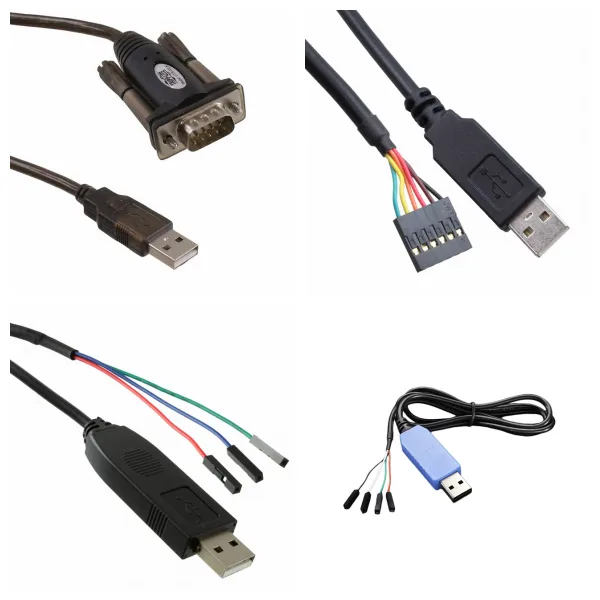
<h1> Smart Cables </h1> <p> Smart Cables are a type of cable product with integrated intelligent control functions. Through built-in microprocessors, communication modules, and other electronic components, they can achieve multi-device collaboration, signal recognition, and adaptive transmission functions that traditional cables cannot support. </p> <p> </p> <h2> 1. What are the Features of Smart Cables? </h2> <p> <strong>Cross-device Collaboration</strong>: Supports peripheral sharing (such as mouse and keyboard), data transmission, and screen sharing between devices such as laptops and desktops, reducing reliance on traditional storage media. </p> <p> <strong>Signal Recognition and Adaptation</strong>: Built-in processing components can identify the type of signal transmitted by the cable (such as data, audio, and video), and automatically adjust the transmission protocol to ensure device compatibility. </p> <p> <strong>Security Authentication</strong>: Cable identity authentication is achieved through chip-level encryption technology to prevent unauthorized device access and improve data transmission security. </p> <p> </p> <h2> 2. What are the Hardware Design of Smart Cables? </h2> <p> <strong>Core Components</strong>: Microcontrollers, communication modules (such as USB protocol chips), and power management units are used to ensure stable power supply and efficient data transmission. </p> <p> <strong>Physical Structure</strong>: Usually a dual-interface design (such as USB Type-A to Type-C), the cable is made of high-strength braided material, and an anti-interference layer is built in to reduce signal loss. </p> <p> </p> <h2> 3. Where are Smart Cables Used? </h2> <p> <strong>Office Scenarios</strong>: Solve problems such as low efficiency of large file transfer between multiple devices and cumbersome peripheral switching, and improve work efficiency. </p> <p> <strong>Industrial Scenarios</strong>: Used in scenarios such as equipment debugging and sensor data collection, simplifying complex connection requirements through adaptive protocols. </p> <p> </p> <h2> 4. What are the Technical Advantages of Smart Cables? </h2> <p> <strong>One Cable for Multiple Uses</strong>: Replace the single function of traditional multiple cables and reduce the occupancy rate of device interfaces. </p> <p> <strong>Low Power Design</strong>: Optimize the power management module to reduce the additional power supply demand of the device. </p> <p> <strong>Summary</strong> </p> <p> Smart Cables solve the problems of single function and poor compatibility of traditional cables through the high integration and intelligent design of electronic components and become an important solution for the interconnection of modern electronic devices. </p> <p>
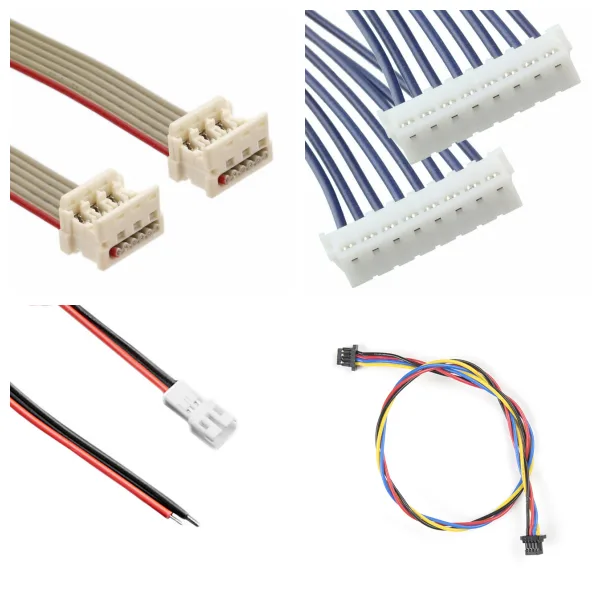
<h1> Rectangular Cable Assemblies </h1> <p> Rectangular Cable Assemblies play the role of efficient connection in electronic systems, and their design needs to take into account functionality, reliability, and environmental adaptability. </p> <p> </p> <h2> 1. Rectangular Cable Assemblies Overview </h2> <p> <strong>Physical Form</strong>: usually flat or rectangular layout design, in contrast to round cable. This type of cable consists of multiple wires, connectors, and protective layers, and has high-density integrated layout characteristics. </p> <p> <strong>Connection Type</strong>: It belongs to the connection type components in electronic components, and needs to cooperate with printed circuit boards (PCBs), ports, etc. to realize signal or power transmission between devices. </p> <p> </p> <h2> 2. What are Rectangular Cable Assemblies Used for? </h2> <p> <strong>Transmission Form</strong>: It supports two modes: signal transmission (such as data communication) and power supply, depending on the wire specifications and connector types. </p> <p> <strong>Application Scenarios</strong>: Internal connection: used for signal communication between modules inside the device, such as data transmission between computer motherboards and hard disks; External interconnection: used as an external interface cable to connect different devices, such as the communication link between sensors and hosts in industrial control systems. </p> <p> </p> <h2> 3. What are the Technical Characteristics of Rectangular Cable Assemblies? </h2> <p> <strong>Reliability Requirements</strong>: It must meet the requirements of anti-interference, wear resistance, and electrical stability in specific environments, which is especially critical in industrial automation or high-frequency communication scenarios. </p> <p> <strong>Standardized Production</strong>: Follow industry standards (such as length, interface type, shielding level, etc.) to ensure compatibility and feasibility of mass production. </p> <p> </p> <h2> 4. Comparison with Other Cable Assemblies </h2> <p> Compared with round cables, rectangular cables are more suitable for scenarios with limited space or high-density wiring; </p> <p> </p> <p> Compared with wire harnesses, they have a more compact structure and are often used for standardized connections with fixed interfaces. </p> <p>
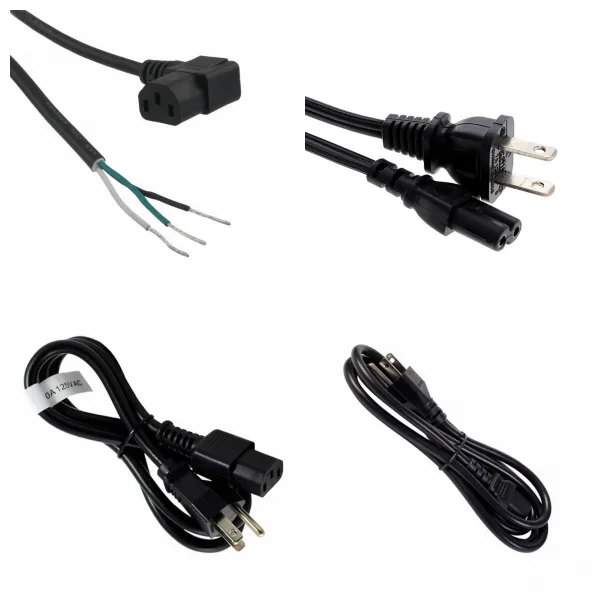
<h1> P<span style="text-decoration: none"></span>ower, Line Cables and Extension Cords </h1> <p> This column focuses on cables and accessories related to power transmission and connection. They are essential basic connection components in electronic systems. Applicable specifications and certified products should be selected in combination with application scenarios. </p> <p> </p> <h2> 1. What are Power, Line Cables and Extension Cords? </h2> <p> <strong>Power Line Cables</strong>: Wires used to transmit current, usually composed of conductors (such as copper, aluminum and other metal materials) and insulation layers (such as PVC, rubber, etc.). Common specifications include 16AWG, 18AWG, etc., suitable for different current carrying requirements. </p> <p> <strong>Extension Cords</strong>: Portable cables with plugs and sockets are used to extend the power connection range and support the long-distance power supply of devices. </p> <p> </p> <h2> 2. Where are Power, Line Cables and Extension Cords Used? </h2> <p> <strong>Current Transmission</strong>: Provides stable power input for electronic devices (such as computer hosts, monitors, household appliances, etc.) to ensure normal operation of the equipment. </p> <p> <strong>Connection Extension</strong>: Use extension cables to solve the problem of power interface distance limitation, which is common in home, industrial and office scenarios. </p> <p> </p> <h2> 3. How to Choose Power, Line Cables and Extension Cords? </h2> <p> <strong>Materials and Processes</strong>: Must comply with safety standards such as fire prevention, high-temperature resistance, and wear resistance, such as UL certification, VDE certification, etc., to ensure reliability. </p> <p> <strong>Electrical Parameters</strong>: Including rated voltage (such as AC 100-240V), current capacity (such as 10A/16A), etc., which must match the equipment requirements. </p> <p> </p> <h2> 4. Classification Attributes for Power, Line Cables and Extension Cords </h2> <p> <strong>Passive Components</strong>: Passive devices that only have the function of power transmission and do not have the ability to amplify or control signals. </p> <p> <strong>Connector Branch</strong>: Classified as electromechanical components (such as connectors and switches), emphasizing physical connection and electrical conduction characteristics. </p> <p>
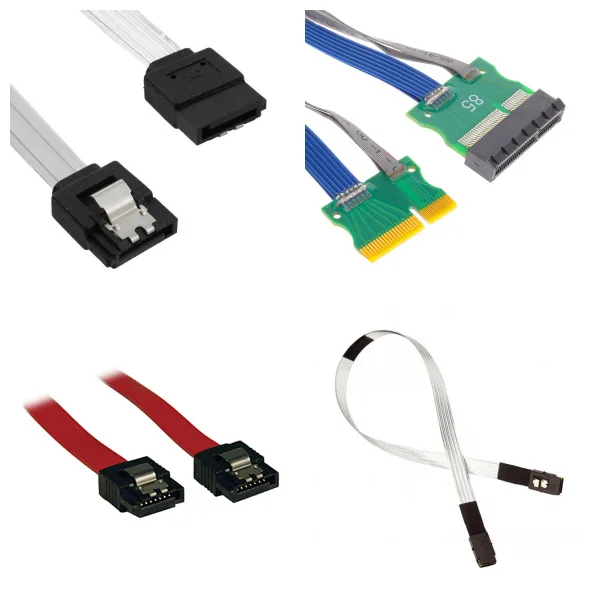
<h1> Pluggable Cables </h1> <p> As an "invisible bridge" in electronic systems, Pluggable Cables support the efficient operation and modular upgrade needs of modern electronic equipment through standardized design and high-performance materials. </p> <p> </p> <h2> 1. Pluggable Cables Overview </h2> <p> Pluggable Cables are a special form of connector, mainly used to achieve pluggable electrical connections between devices or components. Its core functions include: </p> <p> </p> <p> <strong>Signal/Current Transmission</strong>: Through metal contacts or optical fiber media, stable transmission of high-speed data, high-frequency signals, or high-power currents is achieved. </p> <p> <strong>Modular Design</strong>: Supports fast plugging and unplugging, facilitates equipment maintenance, upgrades, or replacements, and reduces downtime. </p> <p> <strong>Protection and Adaptation</strong>: Through shielding layers or sealing structures, electromagnetic interference (EMI), mechanical vibration, and environmental factors (such as dust and humidity) are prevented from affecting connection reliability. </p> <p> </p> <h2> 2. What are the Typical Types of Pluggable Cables? </h2> <p> <strong>Based on application scenarios and technical requirements, pluggable cables can be divided into the following categories</strong>: </p> <p> <strong>Board-end Cable Assembly</strong>: One end is fixed to the circuit board (such as SMT or DIP package), and the other end is connected to the external device, commonly used in computers, communication equipment, etc. </p> <p> <strong>High-frequency/High-speed Cable</strong>: Adopting coaxial or optical fiber structure, supporting high-frequency signal transmission (such as SMA, BNC interface), suitable for RF communication, data center, and other scenarios. </p> <p> <strong>Power Transmission Cable</strong>: Designed as a high-current, high-voltage interface (such as a power adapter, or industrial equipment connector) to ensure the stability of energy transmission. </p> <p> </p> <h2> 3. What are the Key Performance Parameters of Pluggable Cables? </h2> <p> <strong>Mechanical Properties:</strong> The plugging and unplugging force needs to be moderate (typical value: several Newtons to tens of Newtons) to ensure ease of operation and long-term durability. </p> <p> <strong>Electrical Performance</strong>: Low contact resistance (milliohm level) and high insulation resistance (megohm level) to ensure signal integrity and safety. </p> <p> <strong>Environmental Adaptability</strong>: temperature resistance range (-40℃~125℃), corrosion resistance, and shock resistance, meeting the needs of industrial or outdoor applications. </p> <p> </p> <h2> 4. Where are Pluggable Cables Used? </h2> <p> <strong>Consumer Electronics</strong>: charging/data interfaces (such as USB-C, HDMI) for mobile phones and laptops. </p> <p> <strong>Communications and Networks</strong>: fiber optic modules (SFP+, QSFP), base station antenna connections, etc.. </p> <p> <strong>Industrial Control</strong>: PLC systems, sensor cables, robot power interfaces. </p> <p> <strong>Automotive Electronics</strong>: vehicle charging ports, CAN bus connectors, etc.. </p> <p> </p> <h2> 5. Design Considerations for Pluggable Cables </h2> <p> <strong>Key points to pay attention to during development</strong>: </p> <p> <strong>Interface Matching</strong>: physical size, pin definition, and compatibility with target devices. </p> <p> <strong>Transmission Requirements</strong>: bandwidth, current/voltage level, and signal type (digital/analog). </p> <p> <strong>Environmental Factors</strong>: sealing level (such as IP67), anti-interference ability and long-term reliability. </p> <p>
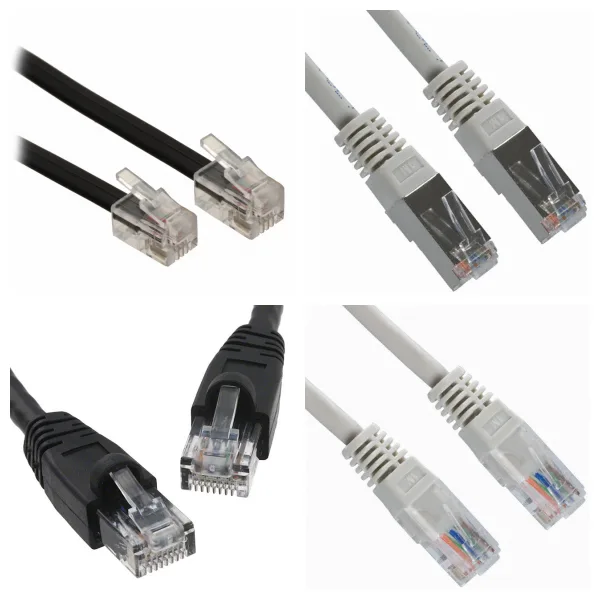
<h1> Modular Cables </h1> <h2> 1. What are Modular Cables? </h2> <p> <strong>Modular Design</strong>: Modular Cables are derived from the modular system. The core is to meet the customized needs of different scenarios through the flexible combination of standardized and interchangeable basic components (such as connectors, cables, etc.). </p> <p> <strong>System Integration</strong>: This type of cable is usually used in conjunction with a modular connector system. For example, in industrial automation and communication equipment, modular cables are used to achieve efficient transmission of power, signals, and data. </p> <p> </p> <h2> 2. What are Modular Cables Used for? </h2> <p> <strong>Industrial Automation</strong>: In automation equipment, Modular Cables are used to connect controllers, sensors, and actuators to ensure stable power supply and signal transmission, while supporting rapid maintenance and expansion. </p> <p> <strong>Complex System Construction</strong>: Similar to the modular solution of Tyco (now TE Connectivity), Modular Cables can be spliced like "building blocks" to build complex connection systems in the fields of automobiles, communications, etc., improving design flexibility and reliability. </p> <p> <strong>High Compatibility</strong>: Through standardized interfaces and cable specifications, modular components of different brands or models can be adapted to reduce customization costs. </p> <p> </p> <h2> 3. What are the Technical Features of Modular Cables? </h2> <p> <strong>Stability and Durability</strong>: In response to challenges such as vibration and temperature changes in industrial environments, Modular Cables usually adopt shielded design and high-strength materials to ensure long-term stable operation. </p> <p> <strong>Customization Capability</strong>: Cable length, shielding level, and connector type (such as RJ45, M12, etc.) can be selected according to needs to adapt to the electrical and mechanical requirements of specific scenarios. </p> <p> </p> <h2> 4. What are the Industry Development Trends of Modular Cables? </h2> <p> <strong>Intelligent Upgrade</strong>: With the advancement of Industry 4.0, Modular Cables are gradually integrating more intelligent features, such as built-in status monitoring functions, and real-time feedback on cable health status. </p> <p> <strong>Standardization and Ecological Integration</strong>: Mainstream manufacturers (such as TE and Molex) are promoting standardized protocols for modular cables to build a more compatible ecosystem. </p> <p> <strong>Summary</strong> </p> <p> Modular Cables are key components for achieving flexible connections in modular systems. Their design takes into account efficiency, reliability, and scalability, and is widely used in industrial automation, communication equipment, and complex electronic systems. </p> <p>
<h1> LGH Cables </h1> <h2> What are LGH Cables? </h2> <p> "LGH Cables" is a high-reliability cable and connector product series designed for aerospace, defense, and marine fields. </p> <p> </p> <h2> What are the Types and Features of LGH Cables? </h2> <p> It covers micro connectors (such as MICRO-MINI series) and standard cable assemblies (such as LGH-1/2L series), supporting different wire diameters (such as 24AWG, 16AWG) and lengths (8 inches to 24.25 inches). </p> <p> </p> <p> The product adopts a standardized interface design and is suitable for signal transmission and power connection needs in harsh environments. </p> <p> </p> <h2> What are LGH Cables Used for? </h2> <p> It is mainly used in scenarios that require high stability and durability, such as avionics equipment, military communication systems, and ship control units. </p> <p>
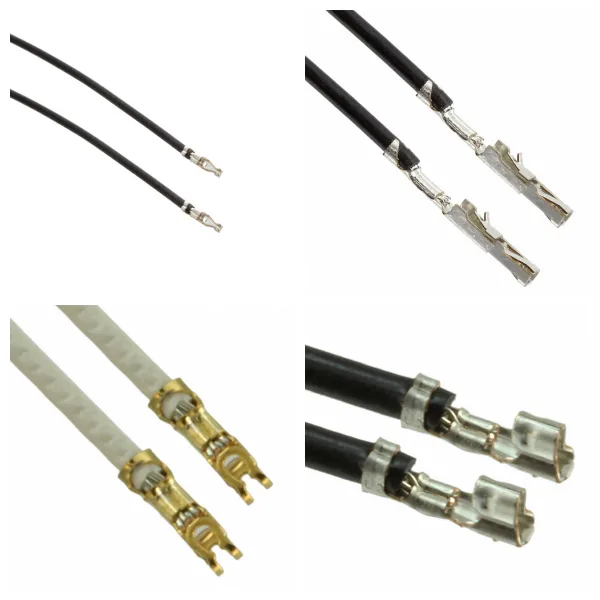
<h1> Jumper Wires, Pre-Crimped Leads </h1> <p> Jumper Wires, Pre-Crimped Leads are a general term for a type of pre-crimped jumper products in electronic components, which are mainly used to quickly build circuit connections or realize signal transmission between modules. With its plug-and-play characteristics, this type of product significantly shortens the deployment cycle of electronic systems and is an indispensable basic component in laboratory development and industrial equipment. </p> <h2> 1. What are Jumper Wires and Pre-Crimped Leads? </h2> <p> It is composed of multiple strands of copper core wires, and the two ends are pre-crimped with terminals of different specifications (such as male, female, rectangular connectors, etc.), without the need for users to solder by themselves. </p> <p> </p> <p> It provides standardized combinations of multiple colors, lengths (such as 2 inches, 6 inches, and 12 inches), and termination forms (M-F, F-F, M-M). </p> <p> </p> <h2> 2. Where are Jumper Wires and Pre-Crimped Leads Used? </h2> <p> <strong>Rapid Prototyping Design</strong>: With the crimp connector housing, it can be flexibly assembled into a customized harness, which is suitable for temporary connection of modules such as development boards and sensors. </p> <p> <strong>Industrial A</strong><strong>utomation</strong>: As a rectangular cable assembly, it is used for the stable connection of high-density ports in control cabinets and PLC equipment. </p> <p> <strong>Equipment Maintenance</strong>: Simplify the repair and upgrade process of electronic equipment by replacing damaged cables or expanding interfaces. </p> <p> </p> <h2> 3. What are the Technical Parameters of Jumper Wires and Pre-Crimped Leads? </h2> <p> <strong>Electrical Performance</strong>: Common voltage rating is 100V, and the current carrying range covers 700mA to higher specifications. </p> <p> <strong>Cable Specifications</strong>: The wire diameter is mainly 24 AWG, and some models support 20 AWG or thinner 28 AWG for higher current. </p> <p> <strong>Durability</strong>: Industrial-grade insulation materials are used to adapt to wide-temperature environments and frequent plug-in and unplug scenarios. </p> <p> </p> <h2> 4. How to Choose Jumper Wires and Pre-Crimped Leads? </h2> <p> <strong>Mainstream Brands</strong>: Including Pololu, Molex, JST, etc., providing product lines with different packaging forms and certification standards (such as RoHS). </p> <p> <strong>Selection Points</strong>: Pay attention to the connector type (such as rectangular, D-Sub), pin number matching, cable length, and termination direction (straight-through or bifurcated). </p> <p>
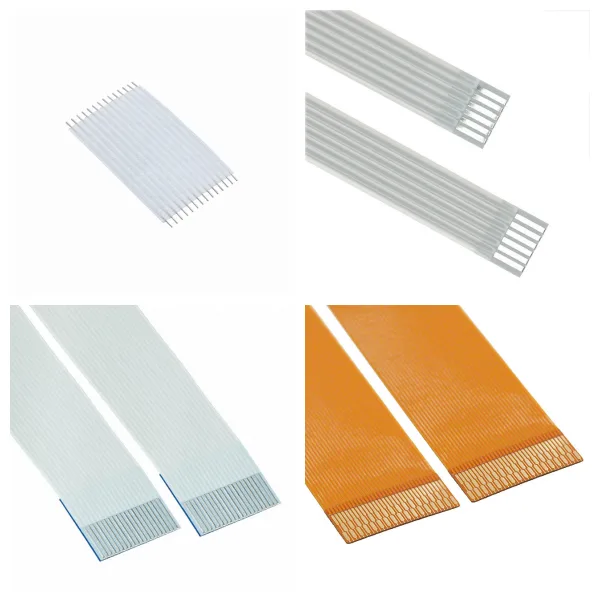
<h1> Flat Flex Ribbon Jumpers, Cables </h1> <h2> 1. What are Flat Flex Ribbon Jumpers Cables? </h2> <p> Flat Flex Ribbon Jumpers and Cables are flexible interconnect components, usually composed of flat conductors and insulating materials, suitable for signal transmission in high-density electronic devices. </p> <p> </p> <p> These products include standardized flexible circuit jumpers (such as the Premo-Flex series) and customized ribbon cables (such as 2.54mm pitch board-to-board connection solutions), and some models support single-ended or differential signal transmission. </p> <p> </p> <h2> 2. What are the Structural Features of Flat Flex Ribbon Jumpers Cables? </h2> <p> <strong>Conductor Material</strong>: Copper alloy conductors are mostly used, and the outer layer is covered with polyimide or polyester film as insulating material. </p> <p> <strong>Pitch Design</strong>: Common pitch specifications include 0.50mm, 1.27mm, 2.0mm, etc., to meet different density requirements. </p> <p> <strong>End Assembly</strong>: Supports a variety of interface options, such as low-profile sockets (CLT series) or terminal blocks (TMMH series). </p> <p> </p> <h2> 3. What are the Technical Parameters of Flat Flex Ribbon Jumpers Cables? </h2> <p> <strong>Wire Gauge and Circuit Count</strong>: Typical parameters include 26 AWG wire diameter, 9-circuit design (up to 0.178 m in length), or 20-bit 0.50 mm pitch cable. </p> <p> </p> <p> <strong>Signal Performance</strong>: Some high-frequency models support 1.1 GHz bandwidth (-3 dB insertion loss). </p> <p> </p> <h2> 4. Where are Flat Flex Ribbon Jumpers Cables Used? </h2> <p> <strong>High-density PCB Interconnection</strong>: Used for board-to-board and module-to-module connections, especially suitable for space-constrained scenarios (such as industrial control equipment). </p> <p> </p> <p> <strong>Customizable Requirements</strong>: Supports Strip and Retain process to adapt to different equipment assembly requirements. </p> <p> </p> <h2> 5. Standardization and Specification of Flat Flex Ribbon Jumpers Cables </h2> <p> E-commerce transactions must follow the "E-commerce Transaction Product Information Description-Electronic Components" (GB/T 32054-2015) standard to clarify requirements such as attribute description and classification model. </p> <p>
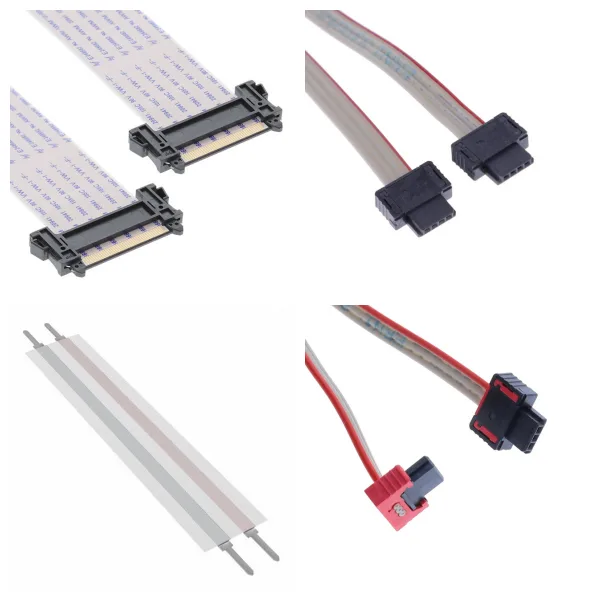
<h1> Flat Flex Jumpers, Cables (FFC, FPC) </h1> <h2> 1. What are Flat Flex Jumpers, Cables (FFC, FPC)? </h2> <p> <strong>FFC (Flexible Flat Cable)</strong> </p> <p> Flexible flat cables are made of metal foil and insulation layers laminated together and are connected to circuits through conductive adhesives. They are thin, light, resistant to bending, and have high transmission speeds. The conductor spacing specifications range from 0.5mm to 2.54mm, which can flexibly adapt to the compact space requirements of different electronic devices and significantly reduce production costs. </p> <p> </p> <p> <strong>FPC (Flexible Printed Circuit)</strong> </p> <p> Flexible printed circuit boards use materials such as polyimide (PI) as substrates, and form customized circuit patterns through etching processes. They support three-dimensional folding and high-density wiring and are suitable for complex bending scenarios. </p> <p> </p> <h2> 2. What are the Structure of Flat Flex Jumpers, Cables (FFC, FPC)? </h2> <p> <strong>FFC structure</strong>: Flat copper foil is sandwiched between PET insulation layers, and the regularly arranged copper wires simplify the conductor design, which is classified as a cable product. </p> <p> <strong>FPC structure</strong>: It includes flexible copper foil, insulation layer, and adhesive, and uses optical imaging and metallized hole processes to achieve multi-layer interconnection, with a high process complexity. </p> <p> </p> <h2> 3. What are the Differences between Flat Flex Jumpers, Cables (FFC, FPC) in Manufacturing Processes? </h2> <p> <strong>FFC</strong>: Mass production through a lamination process, a simple process and low cost. </p> <p> <strong>FPC</strong>: Needs to go through multiple precision processes such as graphic transfer, etching, and lamination, and has a higher technical threshold. </p> <p> </p> <h2> 4. What are the Performance Characteristics of Flat Flex Jumpers, Cables (FFC, FPC)? </h2> <p> <strong>Flexibility</strong>: FPC supports customization of any shape, while FFC can only make regular shapes. </p> <p> <strong>Connection Method</strong>: FFC uses a socket connector, while FPC is compatible with sockets or flat cable clips, which is more flexible. </p> <p> <strong>Temperature Resistance</strong>: The conventional temperature resistance range of both is -40 ℃ to 105 ℃, and special designs can be extended to more severe environments. </p> <p> </p> <h2> 5. What are Flat Flex Jumpers, Cables (FFC, FPC) Used for? </h2> <p> <strong>FFC</strong>: Mainly used in scenes such as LCD panels and camera modules that require high-density connections and high-speed signal transmission. </p> <p> <strong>FPC</strong>: Widely used in environments such as smartphone screens, wearable devices, automotive electronics, and medical instruments that require repeated bending. </p> <p> <strong>Derivative Solution</strong>: Rigid-flexible circuit board (R-FPC) combines rigid and flexible characteristics and is used in high-precision fields such as aerospace and high-end consumer electronics. </p> <p> </p> <h2> 6. Selection Recommendation for Flat Flex Jumpers, Cables (FFC, FPC) </h2> <p> <strong>FFC</strong>: Suitable for standardized, low-cost, and high-speed transmission scenarios. </p> <p> </p> <p> <strong>FPC</strong>: Recommended for designs with limited space, complex bending, or customized wiring. </p> <p>
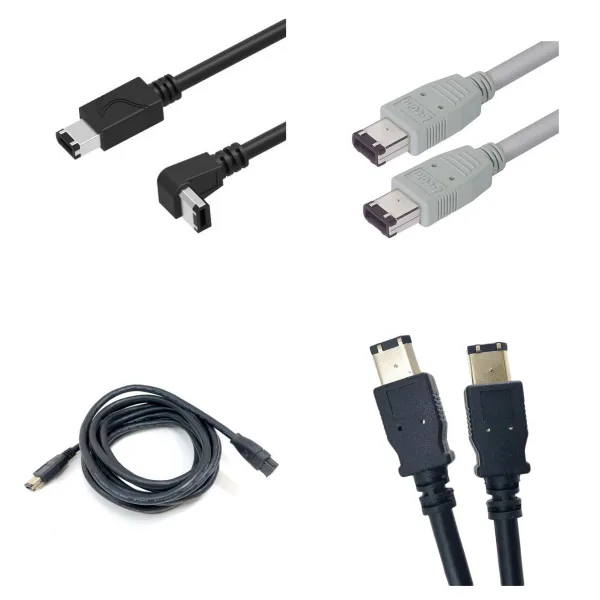
<h1> Firewire Cables (IEEE 1394) </h1> <p> Firewire Cables are special data transmission cables that comply with the IEEE 1394 standard and are mainly used for high-speed serial data transmission. It is highly competitive in high-speed and high-stability transmission scenarios, especially in industrial automation and professional audio and video fields. </p> <p> </p> <h2> 1. What are Firewire Cables? </h2> <h3> 1) Basic Concepts </h3> <p> Firewire Cables are developed based on the IEEE 1394 standard, also known as Firewire interface or i.LINK. It uses differential signal transmission, supports hot-plugging and high-bandwidth transmission, and is suitable for audio and video equipment, computer peripherals, and other scenarios. </p> <p> </p> <h3> 2) Technical Specifications </h3> <p> <strong>Transmission Rate</strong>: The early version (IEEE 1394a) supports 400 Mbps, and subsequent versions can be upgraded to higher speeds. </p> <p> <strong>Topology</strong>: The cable environment is a non-cyclic network that supports multi-node connections. The physical layer contains arbitration logic and port design to ensure bus access fairness. </p> <p> </p> <h2> 2. What are the Technical Features of Firewire Cables? </h2> <p> <strong>Dynamic Environmental Adaptability</strong> </p> <p> Some high-performance Firewire Cables (such as the GORE® FireWire® series) are designed with a flexible design to maintain signal integrity under repeated bending, with a small bending radius and wear resistance. </p> <p> </p> <p> Supports low dust collection and out-gassing characteristics, suitable for clean rooms or vacuum environments (ISO Class 1 certified). </p> <p> </p> <p> <strong>Stability and Compatibility</strong> </p> <p> DS encoding (Data-Strobe) is used to ensure data transmission stability and signal delay is reduced through a resynchronizer. </p> <p> </p> <p> Compatible with the FireWire interface of mainstream devices such as Apple, supporting real-time data transmission and control. </p> <p> </p> <h2> 3. What are Firewire Cables Used for? </h2> <h3> 1) Consumer Electronics and Industrial Fields </h3> <p> <strong>Multimedia Devices</strong>: Real-time audio and video transmission of devices such as cameras and audio interfaces. </p> <p> <strong>Industrial Automation</strong>: Realize high-speed data communication and device control in robots and visual systems. </p> <p> </p> <h3> 2) Computer Peripherals </h3> <p> Connect external storage devices, printers, etc., providing higher transmission efficiency than traditional USB interfaces. </p> <p> </p> <h2> 4. Product Examples of Firewire Cables </h2> <p> <strong>GORE® FireWire® High Flex Cable</strong>: Round or flat design, suitable for dynamic environments, supporting error-free transmission under long-distance bending motion. </p> <p> <strong>Apple FireWire Device Compatible Cable</strong>: Supports fast connection and data transmission between Mac devices and external hardware. </p> <p>
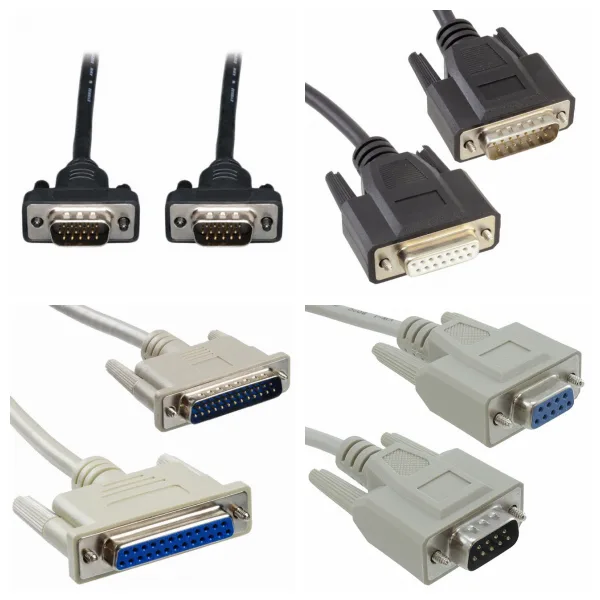
<h1> D-Sub Cables </h1> <p> </p> <p> D-Sub Cables are cable assemblies based on D-Sub connectors, which are widely used for signal transmission and power connection between electronic devices. </p> <p> </p> <h2> 1. What are the Features of D-Sub Cables? </h2> <p> <strong>D-Shaped Shielding Design</strong> </p> <p> D-shaped metal or plastic shell is used to ensure mechanical strength and electromagnetic shielding effect, effectively reducing EMI/RFI interference. </p> <p> </p> <p> The shell is fixed by bolts or thumbscrews, suitable for harsh environments such as vibration and impact. </p> <p> </p> <p> <strong>Contact Layout</strong> </p> <p> Standard models contain two or more rows of parallel pins (common 9, 15, 25, 37, and 50 pins), supporting signal, power, and mixed transmission needs. </p> <p> </p> <p> High-density models integrate more contacts of the same size to meet complex connection needs. </p> <p> <strong>Materials and Protection</strong> </p> <p> Metal shells (such as aluminum alloy, and galvanized steel plate) provide mechanical protection; some models adopt waterproof design, suitable for outdoor or humid environments. </p> <p> </p> <p> The shielded backshell contacts the cable braid to enhance EMI protection. </p> <p> </p> <h2> 2. What are the Types of D-Sub Cables? </h2> <h3> 1) By Size and Pin Arrangement </h3> <p> <strong>Standard Series</strong>: DA (two rows), DB (two rows of high density), DC/DD (three rows), etc., to meet different pin density requirements. </p> <p> <strong>Miniaturized Models</strong>: DE (smallest two rows), Micro-D (special for aerospace), etc., suitable for compact spaces. </p> <p> </p> <h3> 2) By Function and Performance </h3> <p> <strong>Communication Interface</strong>: such as RS-232 (DE-9), VGA (DB-15), and other standardized interfaces. </p> <p> <strong>High-power Model</strong>: supports 75A current, adopts dual-contact or multi-contact layout (such as 5W5), used in electric vehicles and industrial power systems. </p> <p> <strong>Combined Type</strong>: integrates signal, power, and RF interfaces to reduce the number of device I/O. </p> <p> </p> <h2> 3. What are D-Sub Cables Used for? </h2> <p> <strong>Computers and Peripherals</strong>: VGA video cable, serial port (RS-232) communication, early game joystick interface. </p> <p> <strong>Industrial Automation</strong>: Stable signal transmission between PLC, sensors, and control panels. </p> <p> <strong>Communication Equipment</strong>: EMI-sensitive circuit connections for network equipment and test instruments. </p> <p> <strong>High-Reliability Field</strong>: Defense, aerospace, and military equipment rely on its durability and environmental adaptability. </p> <p> </p> <h2> 4. What are the Technical Advantages of D-Sub Cables? </h2> <p> <strong>Reliability</strong>: Metal housing and pin design ensure stability of long-distance transmission and reduce signal attenuation. </p> <p> <strong>Flexibility</strong>: Supports straight/angle outlets, welding wire/crimping termination methods, and adapts to different installation scenarios. </p> <p> <strong>Standardization Evolution</strong>: From early lathe processing terminals to stamping forming processes, costs are reduced, and penetration rates are increased. </p> <p> </p> <h2> 5. Selection Recommendations for D-Sub Cables </h2> <p> <strong>Pin Requirements</strong>: Select the number and layout of contacts according to the signal type (digital/analog/power). </p> <p> <strong>Environmental Adaptability</strong>: Metal housing or waterproof models are preferred to cope with harsh conditions. </p> <p> <strong>Power Requirements</strong>: For high-current scenarios, special high-power contact configurations (such as the Amphenol ICC series) should be used. </p> <p>
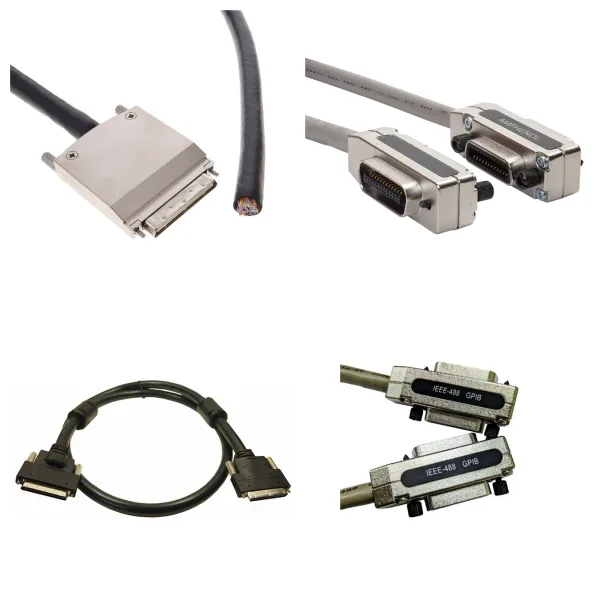
<h1> D-Shaped, Centronics Cables </h1> <h2> What are D-Shaped and Centronics Cables? </h2> <p> <strong>1) D-type Interface</strong>: It adopts a D-shaped metal/plastic shell design, and ensures the stability of the connection through the trapezoidal arrangement of pins. It is commonly found in the serial/parallel ports of computers, printers, and other devices. </p> <p> </p> <p> <strong>2) Centronics Interface</strong>: A standard parallel interface type, originally developed by Centronics, widely used for data transmission between old printers and computers, with multi-pin parallel communication capabilities. </p> <p> </p> <h2> What are D-Shaped and Centronics Cables Used for? </h2> <p> It is mainly used for the physical connection of industrial equipment, data communication equipment, and peripherals, such as high-speed data transmission between printers and hosts, test instruments, and industrial control systems. </p> <p> </p> <p> Some models support shielding design to reduce electromagnetic interference (EMI) and are suitable for high-noise environments. </p> <p> </p> <h2> How to Choose D-Shaped and Centronics Cables? </h2> <p> Main manufacturers include 3M, TE Connectivity, Hirose, etc., providing customized solutions with different pin counts (such as 36 pins and 50 pins), lengths, and shielding levels. </p> <p> </p> <p> When selecting, attention should be paid to the impedance matching, signal integrity, and environmental adaptability (such as temperature resistance and vibration resistance) of the cable. </p> <p> </p> <h2> What are the Technology Trends of D-Shaped and Centronics Cables? </h2> <p> With the popularization of USB and network interfaces, the application scenarios of Centronics interfaces are gradually decreasing, but there is still a stable demand for specific industrial equipment, medical instruments, and maintenance of old systems. </p> <p>
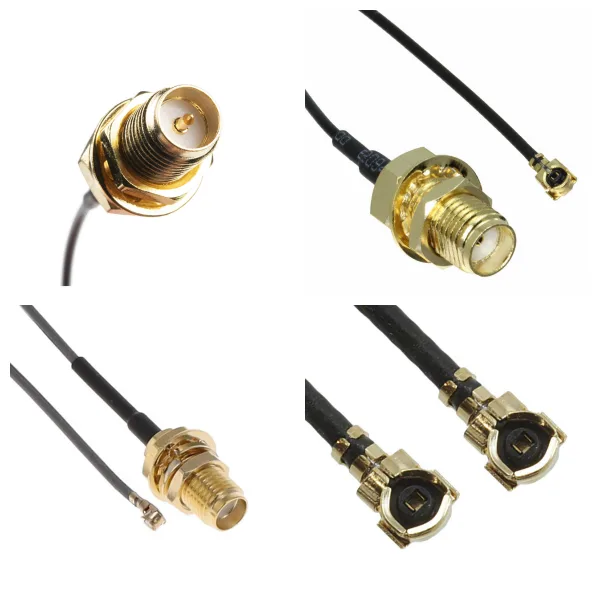
<h1> Coaxial Cables (RF) </h1> <h2> 1. What are the Basic Structure of Coaxial Cables (RF)? </h2> <p> <strong>RF coaxial cable (RF Coaxial Cable) consists of four core parts</strong>: </p> <p> <strong>Inner Conductor</strong>: usually made of copper or silver-plated copper, responsible for signal transmission, the structure can be solid wire or multi-strand twisted wire; </p> <p> <strong>Insulation Layer</strong>: dielectric material (such as polyethylene, polytetrafluoroethylene) wrapped around the inner conductor, used for electrical isolation and supporting the structure; </p> <p> <strong>Outer Conductor</strong>: made of copper braided mesh or aluminum foil, plays an electromagnetic shielding role; </p> <p> <strong>Outer Sheath</strong>: the outermost protective material (such as PVC, PE) to resist environmental erosion. </p> <p> </p> <h2> 2. What are Coaxial Cables (RF) Used for? </h2> <p> RF coaxial cable is widely used in high-frequency signal transmission scenarios, including: </p> <p> Wireless communication (such as base stations and satellite communications); </p> <p> </p> <p> Broadcast and television signal transmission; </p> <p> </p> <p> Test equipment and radar systems; </p> <p> </p> <p> Consumer electronics (such as satellite TV reception). </p> <p> </p> <h2> 3. What are the Types of Coaxial Cables (RF)? </h2> <p> <strong>Divided into two categories according to impedance value</strong>: </p> <p> <strong>50Ω Cable</strong>: mainly used for digital signal transmission and RF energy transmission (such as baseband signal); </p> <p> <strong>75Ω Cable</strong>: commonly used in cable television (CATV) and video signal transmission. </p> <p> </p> <h2> 4. What are the Key Performance Characteristics of Coaxial Cables (RF)? </h2> <p> <strong>Low Loss</strong>: coaxial structure and high-quality materials reduce signal attenuation; </p> <p> High shielding: the outer conductor effectively suppresses electromagnetic interference (EMI); </p> <p> </p> <p> <strong>Wideband Support</strong>: covers the frequency range of 500kHz to 18GHz; </p> <p> <strong>Durability</strong>: the outer sheath material adapts to complex environments (such as temperature changes and mechanical wear). </p> <p> </p> <h2> 5. What are the Technical Parameters of Coaxial Cables (RF)? </h2> <p> <strong>Attenuation (Insertion Loss)</strong>: increases with increasing frequency, in dB/length; </p> <p> <strong>Bending Radius</strong>: the minimum bending radius to ensure performance; </p> <p> <strong>Connector Matching</strong>: needs to be adapted to RF connectors such as SMA and BNC to ensure impedance continuity; </p> <p> <strong>Propagation Speed</strong>: the ratio to the speed of light affects signal delay. </p> <p> </p> <h2> 6. What is the Development Trend of Coaxial Cables (RF)? </h2> <p> With the popularization of 5G communications and satellite technology, RF coaxial cables are developing towards higher frequency bands (such as millimeter waves), lower losses, and lightweight materials. </p> <p>
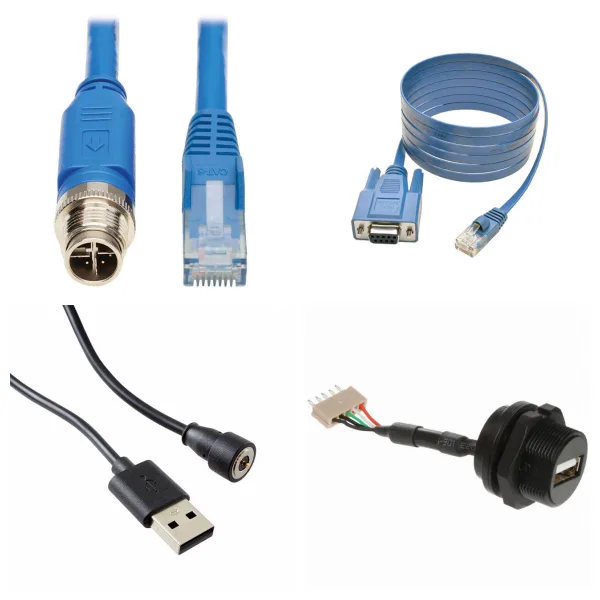
<h1> Between Series Adapter Cables </h1> <h2> 1. What are Between Series Adapter Cables? </h2> <p> <strong>Definition</strong>: It is an interconnection cable that adapts to different series of connectors and is used to solve the physical connection problem between devices with different interface standards or series. </p> <p> <strong>Core Function</strong>: By converting the physical interface of the connector (such as RF series, polarity, gender, etc.), signal transmission or power transmission across a series of devices can be realized. </p> <p> </p> <h2> 2. What are the Technical Parameters of the Between Series Adapter Cables? </h2> <p> <strong>Direction</strong>: Such as straight type (Straight); </p> <p> <strong>Adaptation Series</strong>: The connectors on both sides may belong to different RF series (such as SMA, BNC, N-type, etc.); </p> <p> <strong>Frequency Range</strong>: It needs to meet the maximum frequency requirements of specific application scenarios (such as high-frequency RF systems); </p> <p> <strong>Impedance Matching</strong>: Commonly 50Ω or 75Ω, it needs to be consistent with the system impedance to reduce signal reflection. </p> <p> </p> <h2> 3. What are the Types of the Between Series Adapter Cables? </h2> <p> <strong>1) By Application Scenario</strong>: It can be divided into RF adapter cable, power adapter cable, etc.; </p> <p> <strong>2) By Interface Type</strong>: </p> <p> Side 1 and side 2 may have different genders (male/female) or polarities; </p> <p> </p> <p> Adapter types include plug-in type, transfer type, etc. </p> <p> </p> <h2> 4. What are the Between Series Adapter Cables Used for? </h2> <p> <strong>RF System</strong>: Used to connect RF signals between test instruments and communication equipment; </p> <p> <strong>Hardware Device Interconnection</strong>: In industrial equipment or network equipment, cables with different interface standards (such as console interface and power interface) are connected. </p> <p> </p> <h2> 5. How to choose the Between Series Adapter Cables? </h2> <p> It is necessary to clarify the series, gender, polarity, and other parameters of the connectors on both sides; </p> <p> </p> <p> Pay attention to RF performance indicators such as maximum operating frequency, impedance matching, VSWR (voltage standing wave ratio); </p> <p> </p> <p> Prioritize products from manufacturers that comply with RoHS standards and are certified. </p> <p> </p> <p> As a key component for cross-series connection, the design and selection of Between Series Adapter Cables need to be closely combined with the actual interface standards and system requirements to ensure signal integrity and device compatibility. </p> <p>
<h1> Barrel Connector Cables </h1> <p> Barrel Connector Cables consist of free-hanging barrel connectors factory installed on compatible cables categorized by their compatibility with free hanging, board, and panel mount mating connectors. Common configurations are jack to plug, plug to plug, jack to jack, and jack to wire leads with options for right angle styles and double connected ends. </p> <p>
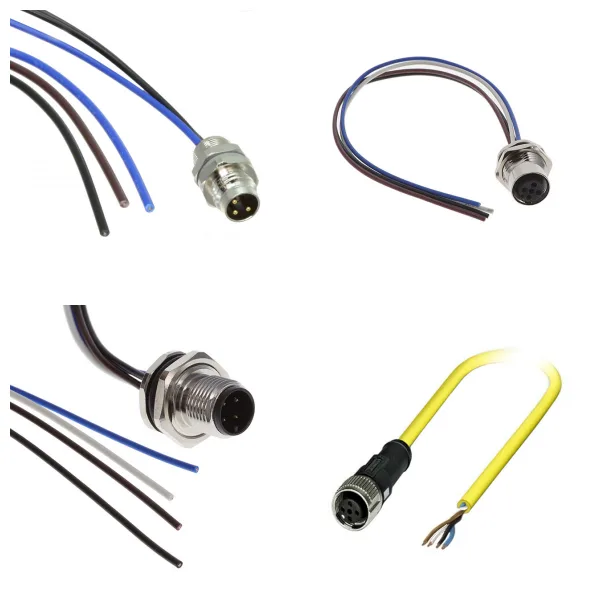
<h1> Circular Cable Assemblies </h1> <p> Circular Cable Assemblies are a special type of cable assembly in the field of electronic interconnection, designed for harsh environments and complex scenarios. </p> <p> </p> <h2> 1. What are the Structural Design of Circular Cable Assemblies? </h2> <p> The circular connector shell supports high-density contact arrangement, especially in miniaturized design, it can still maintain the stability of multi-pin configuration. </p> <p> </p> <p> The connector gender (male/female) is decoupled from the shell gender, with high design flexibility to meet customized needs. </p> <p> </p> <p> The cable diameter covers 0-26 AWG, which is suitable for different current and signal transmission needs. </p> <p> </p> <h2> 2. What are Circular Cable Assemblies Used for? </h2> <p> <strong>Military and Shipbuilding</strong>: Certified by MIL standards, resistant to extreme temperatures, vibration, humidity, and electromagnetic interference, suitable for shipborne equipment, field communications, and other scenarios. </p> <p> <strong>Industrial Equipment</strong>: Used for signal and power transmission with high-reliability requirements such as factory automation and robot control. </p> <p> <strong>Aerospace</strong>: Meet the needs of lightweight, radiation resistance, and high sealing. </p> <p> </p> <h2> 3. What are the Advantages of Circular Cable Assemblies? </h2> <p> <strong>Withstand Voltage and Durability</strong>: Package size and material selection directly affect to withstand voltage levels, and large packages can support higher voltage environments. </p> <p> <strong>Signal Integrity</strong>: Reduce signal attenuation and crosstalk through shielding design and high-quality insulation materials (such as nylon and metal oxide film). </p> <p> <strong>Fast Deployment</strong>: Modular design supports plug-and-play and reduces the complexity of on-site installation. </p> <p> </p> <h2> 4. Typical Manufacturers of Circular Cable Assemblies </h2> <p> <strong>Electro Standards</strong>: Provides MIL standard circular custom cable assemblies that support multi-pin arrangement and miniaturized design. </p> <p> <strong>Molex</strong>: Produces high-density interconnect solutions such as Mini-LC fiber optic assemblies to meet the needs of miniaturized equipment. </p> <p> </p> <h2> 5. How to Choose Circular Cable Assemblies? </h2> <p> Choose products that meet IP ratings or MIL certifications based on the working environment (temperature, humidity, vibration). </p> <p> </p> <p> In high-density scenarios, parameters such as pin spacing and contact resistance are prioritized to ensure long-term stability. </p> <p> </p> <p> Such components play a key role in complex system integration and require balancing performance, cost, and reliability based on specific scenarios. </p> <p>
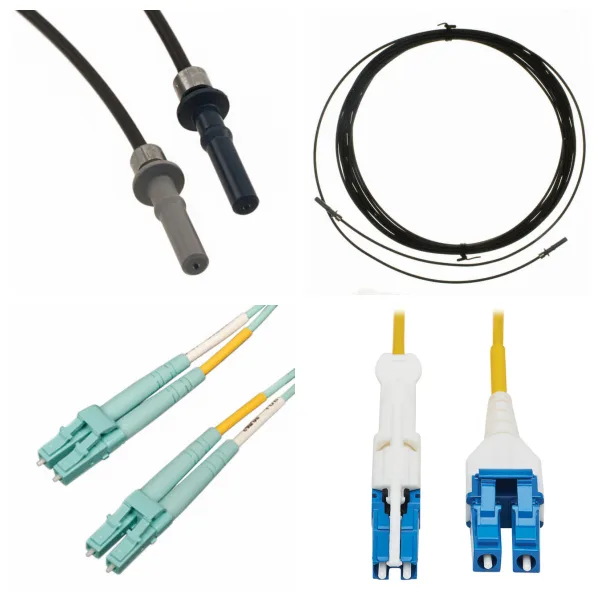
<h1> Fiber Optic Cables </h1> <p> Optical fiber cables have become the core transmission medium of modern high-speed communication networks and will continue to promote the innovation of communication technology in the future. </p> <p> </p> <h2> 1. What are Fiber Optic Cables? </h2> <p> <strong>Fiber optic cables consist of one or more optical fibers, using light pulses for high-speed data transmission, and are suitable for telecommunications, the Internet, and long-distance communications. Its typical structure includes</strong>: </p> <p> <strong>Core</strong>: Made of high-purity quartz glass (SiO₂) or plastic, responsible for conducting optical signals. </p> <p> <strong>Cladding</strong>: Surrounding the core, with a low refractive index to achieve total internal reflection. </p> <p> <strong>Coating</strong>: Protects the optical fiber from physical damage. </p> <p> <strong>Strengthening Elements and Outer Sheath</strong>: Provide tensile strength and environmental protection. </p> <p> </p> <h2> 2. How do Fiber Optic Cables work? </h2> <p> Based on the principle of total internal reflection, the optical signal is repeatedly reflected and transmitted forward at the interface between the core and the cladding. The optical signal propagates at a speed of about 200,000 kilometers per second, supporting ultra-low latency communications. </p> <p> </p> <h2> 3. What are the Types of Fiber Optic Cables? </h2> <p> <strong>Single-mode Fiber (SMF)</strong>: The core diameter is extremely thin (about 9μm), and it transmits a single wavelength, which is suitable for long-distance, high-speed communications (such as submarine optical cables). </p> <p> <strong>Multimode Fiber (MMF)</strong>: The core diameter is relatively wide (50-62.5μm), supports multi-wavelength transmission, and is suitable for short-distance scenarios (such as local area networks). </p> <p> <strong>Other Types</strong>: Include tight-packed optical cables, branch optical cables, ribbon optical cables, etc., to meet the mechanical and performance requirements of different scenarios. </p> <p> </p> <h2> 4. What are the Technical Advantages of Fiber Optic Cables? </h2> <p> <strong>High Bandwidth and Speed</strong>: Supports transmission rates of 10Gbps to 100Gbps, and the theoretical capacity can reach tens of billions of voice channels. </p> <p> <strong>Low Loss and Long Distance</strong>: The relay distance can reach thousands of kilometers, far exceeding traditional copper cables. </p> <p> <strong>Strong Anti-interference Ability</strong>: Not subject to electromagnetic interference, suitable for complex electromagnetic environments. </p> <p> <strong>Lightweight and Durable</strong>: Small size, lightweight, and corrosion-resistant. </p> <p> </p> <h2> 5. What are Fiber Optic Cables Used for? </h2> <p> <strong>Communication Infrastructure</strong>: Internet backbone network, telephone system, and cable TV network. </p> <p> <strong>Private Network</strong>: enterprise dedicated line, data center interconnection. </p> <p> <strong>Special Environment</strong>: submarine communication (submarine cable), industrial anti-interference transmission, etc.. </p> <p> </p> <h2> 6. What are the Materials of Fiber Optic Cables? </h2> <p> Mainstream communication optical fiber is mainly made of quartz glass and is made through a precision drawing process; </p> <p> </p> <p> Plastic optical fiber is used in some scenarios, but the performance is relatively limited. </p> <p> </p> <h2> 7. What is the Development Trend of Fiber Optic Cables? </h2> <p> <strong>High-core Optical Cable</strong>: Increase the transmission capacity of the unit cable. </p> <p> <strong>All-optical Network</strong>: Promote low-loss, high-reliability optical communication system. </p> <p>










